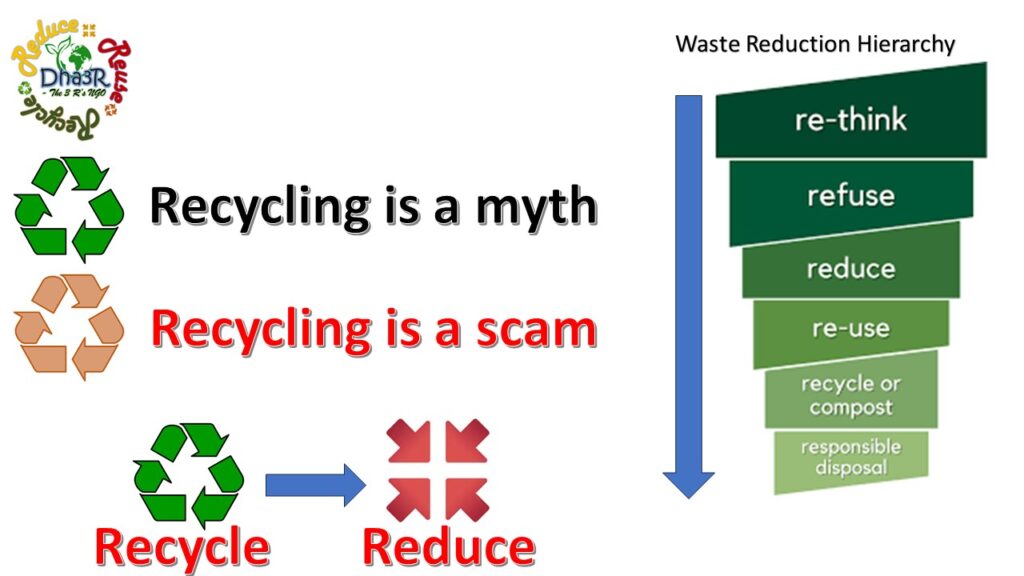
The Plastic Recycling Myth: How It’s Fueling the Plastic Problem
Introduction
Plastic recycling has long been hailed as a solution to the environmental challenges posed by the global plastic crisis. Many of us have felt a sense of relief when we toss our empty water bottles or old food containers into the recycling bin, thinking that we’re doing our part to reduce the environmental impact of plastics. However, the reality is far more complex. In this blog, we’ll explore the myth of plastic recycling and how, paradoxically, it may be contributing to the ever-growing problem of plastic pollution.
- The Illusion of Recycling
Plastic recycling is often presented as a straightforward process where discarded plastic items are collected, sorted, cleaned, melted down, and transformed into new products. While this idealized image of recycling exists, the actual recycling rate for plastics is abysmally low. In the United States, for example, only about 8% of plastics get recycled. Globally, less than 10% of plastic waste is recycled. India’s plastic recycling average of 13% surpasses the global average of 10% and even outperforms some developed economies with only 4%. Also, the process of recycling is prohibitively expensive.
- Downcycling: A Compromised Solution
One of the reasons behind the low plastic recycling rates is a phenomenon known as downcycling. When plastic products are recycled, they often undergo a transformation that results in lower-quality materials. For instance, a high-quality plastic bottle may be downcycled into a lower-quality product, such as a lower-grade plastic container or textiles. These downcycled products are less valuable and, in many cases, cannot be recycled again.
- Contamination and Sorting Challenges
Another issue with plastic recycling is contamination. Plastic items often come into contact with various substances, making them challenging to clean and recycle effectively. Many plastics are also made from a blend of materials, which further complicates the recycling process. This contamination and complexity lead to inefficiencies in sorting and processing at recycling facilities. Also, recycling process itself is environmentally harmful, exposing workers to toxic chemicals and itself generating microplastics. Recycled plastic carries toxicity risks through contamination with other plastic types in collection bins, preventing it from becoming food-grade material again.
- Exporting the Problem
In some cases, developed countries have exported their plastic waste to other nations. This practice, while intended to divert plastic from landfills at home, has caused significant problems in recipient countries. Many of these nations lack the infrastructure and resources to manage the vast quantities of plastic waste they receive, leading to environmental pollution and health hazards.
- The False Sense of Responsibility
The existence of recycling programs can create a false sense of responsibility among consumers and industries. When individuals believe that their plastic waste is being recycled, they may not be as motivated to reduce their plastic consumption or seek more sustainable alternatives. Similarly, Plastics producing companies ditch customers this way and produce more and more plastics.
- The Demand for New Plastics
Recycling plastics effectively relies on the demand for recycled materials. Unfortunately, there is often a limited market for recycled plastics. Many industries prefer virgin (new) plastic for its consistency and reliability, which discourages the use of recycled materials. “New plastic directly competes with recycled plastic, and it’s far cheaper to produce and of higher quality,” said the studies.
- The Role of the Petrochemical Industry
The petrochemical industry, responsible for the production of new plastics, plays a significant role in the persistence of the plastic problem. The industry often lobbies against regulations that could reduce plastic production and consumption. This results in a vicious cycle where plastic production continues to grow, making recycling less effective.
Conclusion
While plastic recycling may appear to be a solution to the growing plastic problem, it has largely become a myth that contributes to the issue. The low recycling rates, downcycling, contamination challenges, and the reliance on virgin plastics all perpetuate the environmental crisis caused by plastic pollution. To address this problem effectively, it is crucial to focus on reducing plastic production, promoting alternatives, and advocating for policies that hold producers accountable for the environmental impact of their products. The plastic crisis is too severe to be solved solely by recycling; it demands a comprehensive and systemic approach to reduce our reliance on plastic and mitigate its adverse effects on the environment.
So, focus on REDUCE than RECYCLE.